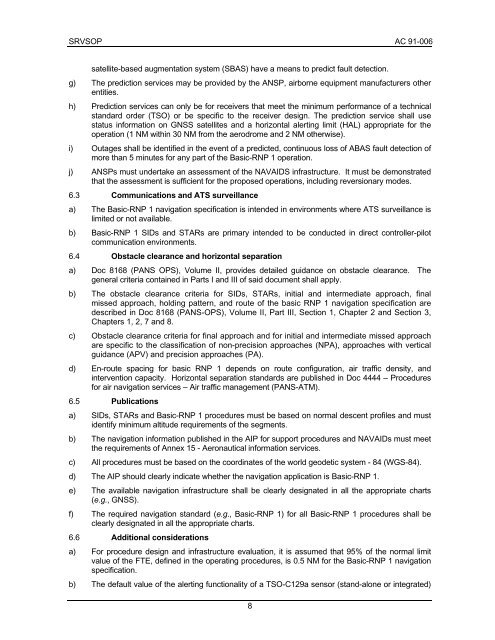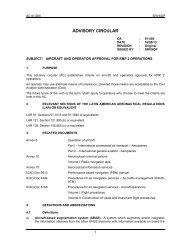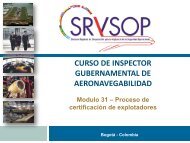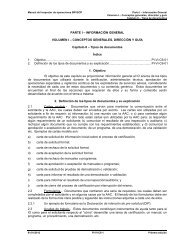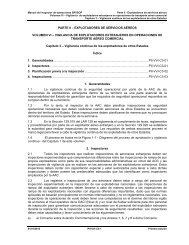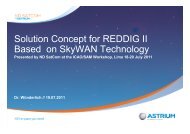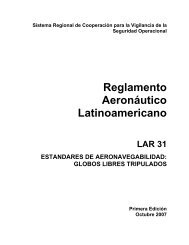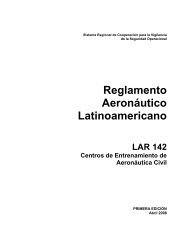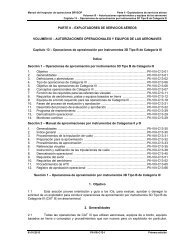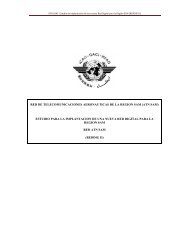ac 91-006 srvsop - ICAO
ac 91-006 srvsop - ICAO
ac 91-006 srvsop - ICAO
Create successful ePaper yourself
Turn your PDF publications into a flip-book with our unique Google optimized e-Paper software.
SRVSOP AC <strong>91</strong>-<strong>006</strong><br />
satellite-based augmentation system (SBAS) have a means to predict fault detection.<br />
g) The prediction services may be provided by the ANSP, airborne equipment manuf<strong>ac</strong>turers other<br />
entities.<br />
h) Prediction services can only be for receivers that meet the minimum performance of a technical<br />
standard order (TSO) or be specific to the receiver design. The prediction service shall use<br />
status information on GNSS satellites and a horizontal alerting limit (HAL) appropriate for the<br />
operation (1 NM within 30 NM from the aerodrome and 2 NM otherwise).<br />
i) Outages shall be identified in the event of a predicted, continuous loss of ABAS fault detection of<br />
more than 5 minutes for any part of the Basic-RNP 1 operation.<br />
j) ANSPs must undertake an assessment of the NAVAIDS infrastructure. It must be demonstrated<br />
that the assessment is sufficient for the proposed operations, including reversionary modes.<br />
6.3 Communications and ATS surveillance<br />
a) The Basic-RNP 1 navigation specification is intended in environments where ATS surveillance is<br />
limited or not available.<br />
b) Basic-RNP 1 SIDs and STARs are primary intended to be conducted in direct controller-pilot<br />
communication environments.<br />
6.4 Obst<strong>ac</strong>le clearance and horizontal separation<br />
a) Doc 8168 (PANS OPS), Volume II, provides detailed guidance on obst<strong>ac</strong>le clearance. The<br />
general criteria contained in Parts I and III of said document shall apply.<br />
b) The obst<strong>ac</strong>le clearance criteria for SIDs, STARs, initial and intermediate appro<strong>ac</strong>h, final<br />
missed appro<strong>ac</strong>h, holding pattern, and route of the basic RNP 1 navigation specification are<br />
described in Doc 8168 (PANS-OPS), Volume II, Part III, Section 1, Chapter 2 and Section 3,<br />
Chapters 1, 2, 7 and 8.<br />
c) Obst<strong>ac</strong>le clearance criteria for final appro<strong>ac</strong>h and for initial and intermediate missed appro<strong>ac</strong>h<br />
are specific to the classification of non-precision appro<strong>ac</strong>hes (NPA), appro<strong>ac</strong>hes with vertical<br />
guidance (APV) and precision appro<strong>ac</strong>hes (PA).<br />
d) En-route sp<strong>ac</strong>ing for basic RNP 1 depends on route configuration, air traffic density, and<br />
intervention cap<strong>ac</strong>ity. Horizontal separation standards are published in Doc 4444 – Procedures<br />
for air navigation services – Air traffic management (PANS-ATM).<br />
6.5 Publications<br />
a) SIDs, STARs and Basic-RNP 1 procedures must be based on normal descent profiles and must<br />
identify minimum altitude requirements of the segments.<br />
b) The navigation information published in the AIP for support procedures and NAVAIDs must meet<br />
the requirements of Annex 15 - Aeronautical information services.<br />
c) All procedures must be based on the coordinates of the world geodetic system - 84 (WGS-84).<br />
d) The AIP should clearly indicate whether the navigation application is Basic-RNP 1.<br />
e) The available navigation infrastructure shall be clearly designated in all the appropriate charts<br />
(e.g., GNSS).<br />
f) The required navigation standard (e.g., Basic-RNP 1) for all Basic-RNP 1 procedures shall be<br />
clearly designated in all the appropriate charts.<br />
6.6 Additional considerations<br />
a) For procedure design and infrastructure evaluation, it is assumed that 95% of the normal limit<br />
value of the FTE, defined in the operating procedures, is 0.5 NM for the Basic-RNP 1 navigation<br />
specification.<br />
b) The default value of the alerting functionality of a TSO-C129a sensor (stand-alone or integrated)<br />
8


